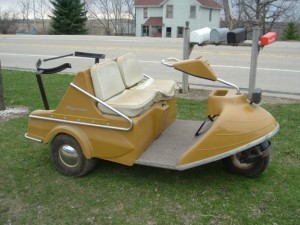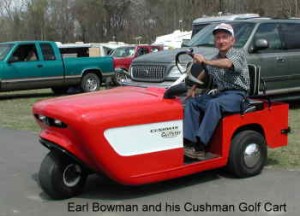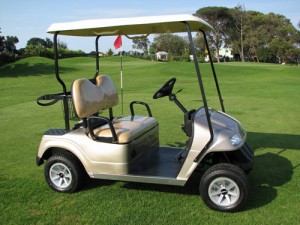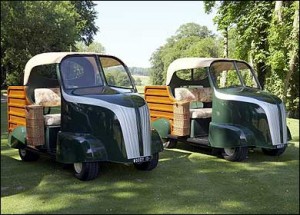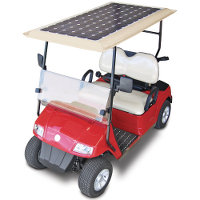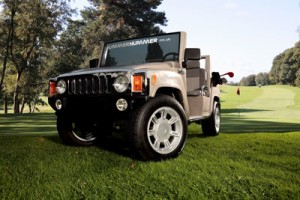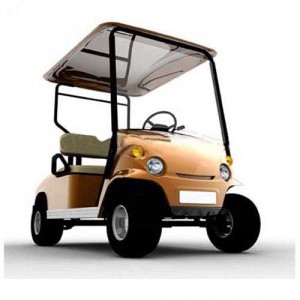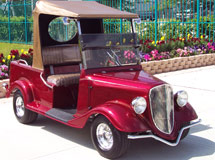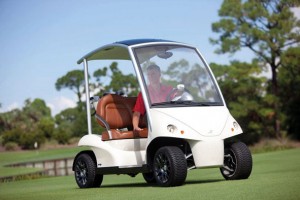Since its early days Golf was a sport to be enjoyed while walking through the courses; players chose to carry their own golf clubs or hired a caddy. Then the appearance (in the 1940’s) of the golf buggy (or golf cart) changed the whole game. Originally created for golfers with disabilities these funny looking vehicles quickly became popular first as status symbols for the wealthy and then with the retirement communities that were being created in the United States.
A standard golf buggy is set up to carry two golfers and two golf bags on a platform at the rear of the cart. The first models were electrically powered, Merle Williams of Long Beach, California was an early innovator of the electric golf car, using his knowledge of electric cars spurred by gas rationing during WWII, developed the first model in Southern California. Later models, developed by companies such as Harley-Davidson, were powered by gas. In 1953, only the players at very exclusive clubs used golf carts, but by 1959 they had increased in popularity. Electric golf cars were the first mass-produced electric vehicles for private consumer use.
Since the mid 1980’s the growing concerns about the environmental impact of the vehicles turned the attention of the golf buggy manufacturers to environmentally friendly models in order to achieve lack of pollutants and an healthy lack of noise so much appreciated around the course, most of the Golf Clubs are now using electric golf buggies nowadays solar-powered models are being produced adding more benefits to the environment. In some states in the U.S.A. golf buggies are licensed to be driven on public streets, and in some retirement resort communities residents are more likely to own golf carts than cars and obliviously that helps cut down on pollution. A wide variety of models is available today in today’s market, from standard to custom made models depending on your personal tastes and budget the choice is yours!
If you always been afraid to ask how is a golf buggy driven take a look below;
Starting it: Ensure that the brake is pressed down firmly and locked into place before starting, as most golf buggies will not start unless the brake is on as a precaution always double check if the break is pressed. Put the key in the ignition and turn it gently to the “On” position, as you are not starting an engine a simple and gentle flick of the wrist is all you will need to start the buggy. Mind that since the majority of golf carts are electric-powered, you will not “hear” it start. Always assume that the buggy is running when in the “On” position.
Put the golf buggy in gear. Most have two gears: “F” for forward and “R” for reverse. Make sure the lever is locked into place before continuing with the next step.
Driving it: Gently press on the gas. And we mean “gently.” Press until you hear the brake pop out of the locked position. Golf buggies start off at their full horse power, so be prepared for a slight jolt. Slow down when making sharp turns because golf carts can topple over quite easily. You’ll also want to keep both hands on the steering wheel when making turns. Power steering is not a standard feature in golf buggies, so you need a little extra muscle power when making hairpin turns. Be sure that when your ride is over you press firmly on the brake until you hear it click into place. Always remove the keys whenever the cart is not in use.
Related posts
Golf Books #255 (The Little Book of Golf Tips)
on Tuesday 1, MayA huge helping hand for your handicap, “The Little Book of Golf Tips” will...
Golf Books #234 (From Green to Tee)
on Tuesday 28, NovemberAll proceeds of this book benefit junior golf and women’s college golf programs.* As...
Golf Books #15 (Golf My Way: The Instructional Classic, Revised and Updated)
on Monday 3, JanuaryHailed as a classic and read everywhere golf is played, “Golf My Way” has...

